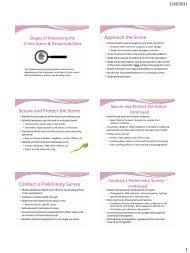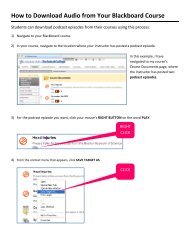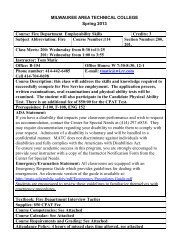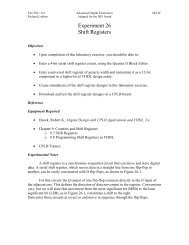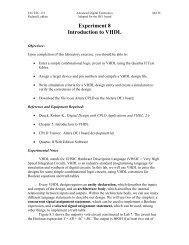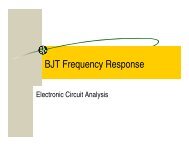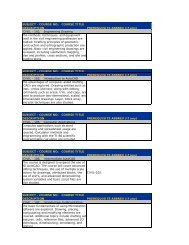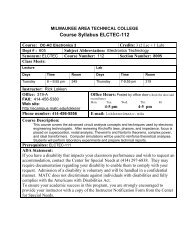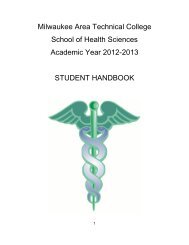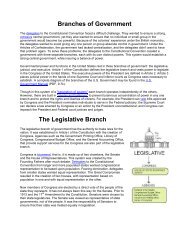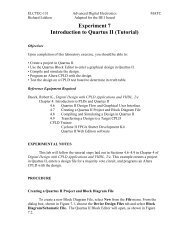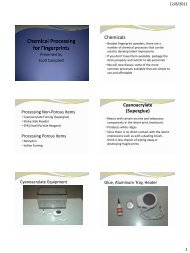WI Forward Award 2012 - Welcome to MATC - Milwaukee Area ...
WI Forward Award 2012 - Welcome to MATC - Milwaukee Area ...
WI Forward Award 2012 - Welcome to MATC - Milwaukee Area ...
Create successful ePaper yourself
Turn your PDF publications into a flip-book with our unique Google optimized e-Paper software.
Leadership: Category 1<br />
staffing needs and trends. Training sessions on succession<br />
planning were held in 2009-10, and vice presidents developed<br />
plans for their areas <strong>to</strong> identify options for future succession and<br />
leadership development needs. Stretch assignments are given<br />
<strong>to</strong> individuals <strong>to</strong> enhance their skills and exposure <strong>to</strong> areas and<br />
processes outside their current assignments. These tasks are<br />
moni<strong>to</strong>red <strong>to</strong> identify successes and further training needs.<br />
1.1.b COMMUNICATION<br />
AND ORGANIZATIONAL PERFORMANCE<br />
1.1.b(1) Communication<br />
Because of the size of our workforce on four campuses, <strong>MATC</strong><br />
leaders use a variety of methods <strong>to</strong> communicate with the<br />
various stakeholders. Figure 1-1c presents an overview of the<br />
various communication vehicles and their frequency among our<br />
stakeholder groups.<br />
Senior leaders practice open, two-way communication<br />
throughout the organization through many methods that<br />
reflect our values of Excellence and Accountability. Internal<br />
surveys indicate room for improvement in this area. As a result,<br />
objectives, strategies, and action plans connected <strong>to</strong> our strategic<br />
goal of enhancing relationships have been adjusted <strong>to</strong> focus on<br />
our internal communication systems. Since 2005, <strong>MATC</strong> has<br />
used Conversation Days as a way <strong>to</strong> specifically engage the<br />
college community regarding areas of improvement. These<br />
annual events are held at each campus, and in 2008 online<br />
discussion boards were added <strong>to</strong> encourage more participation.<br />
The results of these conversations can lead <strong>to</strong> either “quick<br />
fixes” or formal action projects. Annually, college leadership<br />
reviews this feedback along with input gathered from a variety<br />
of stakeholders, research studies compiled by IRSP and SWOT<br />
analyses <strong>to</strong> understand college, community, and employment<br />
trends that will affect student, industry, and community needs.<br />
Key announcements of changes, decisions, and other pertinent<br />
information are presented <strong>to</strong> the community either through<br />
the email, posted on our website, and/or publicized in media<br />
releases, as appropriate. For the first time in February <strong>2012</strong>,<br />
a non-student contact day usually used for faculty in-service<br />
training was transformed <strong>to</strong> the first annual “<strong>MATC</strong> Day.” A<br />
shared-governance committee planned this day <strong>to</strong> celebrate<br />
the college’s achievements with a focus on student completion<br />
as a school-wide effort for the future. All faculty, staff, and<br />
administration were invited <strong>to</strong> the day’s events, including<br />
listening <strong>to</strong> student speakers share their s<strong>to</strong>ries.<br />
Members of the administration also take an active role in<br />
recognition programs that reinforce high performance and<br />
student learning, including scholarship events, the Lamp of<br />
Knowledge ceremony, and banquets held for: student athletes,<br />
African-American students, and honor societies, <strong>to</strong> name a few.<br />
Recently, changes were made by the Provost’s Office regarding<br />
inclusion of students on the Dean’s List, lowering the number<br />
of required credits for students <strong>to</strong> be eligible for recognition <strong>to</strong><br />
six while adding additional levels of acknowledgment. Now,<br />
students taking at least six credits per semester with a 3.5 – 3.74<br />
GPA are placed on the Dean’s List, those achieving a 3.75 – 3.99<br />
GPA are on the Provost’s List, and earning a 4.0 GPA puts them<br />
on the President’s List. These changes resulted in more students<br />
being recognized for academic achievements.<br />
Employee contributions <strong>to</strong> the college and community<br />
are formally recognized by the president in the monthly<br />
Communiqué newsletter, distributed <strong>to</strong> the <strong>MATC</strong> community<br />
online and posted on the website. The president also developed<br />
“Burke’s Blog” this year, posted on the <strong>MATC</strong> website, <strong>to</strong> better<br />
communicate with constituent groups, students, and the public<br />
(Figure 7-3h #1).<br />
1.1.b(2) Focus on Action<br />
Leaders focus on action plans <strong>to</strong> accomplish <strong>MATC</strong>’s strategic<br />
goals, improve performance, and achieve the college’s vision<br />
by aligning improvement projects with the mission, vision, and<br />
values through the strategic planning and budgeting processes.<br />
Further, vice presidents, deans, and managers develop specified<br />
plans for their areas based on the college’s foci and needs of<br />
their areas that are aligned with the mission, vision and Strategic<br />
Plan. Through the performance evaluation process, each nonrepresented<br />
employee aligns their goals <strong>to</strong> the strategic and<br />
divisional plan. Improvement projects are then carried forward<br />
in<strong>to</strong> the academic, budget, facility, and technology planning<br />
processes. In this process, actions are identified in a number of<br />
ways as described in Category 2. Improvement opportunities are<br />
also identified through innovation grants, <strong>MATC</strong> Foundation<br />
initiatives, and through communication with feeder schools,<br />
transfers schools, and business and industry partners. In<br />
addition, program Advisory Committees and faculty provide<br />
knowledge of industry and community changes and trends. This<br />
information is used <strong>to</strong> adapt and update academic programming.<br />
College leaders remain focused on creating value for students<br />
and other stakeholders by identifying short- and long-term<br />
goals and objectives for the institution and working <strong>to</strong> achieve<br />
those goals. With equal representation of faculty and staff,<br />
core committees are linked <strong>to</strong> specific strategic goals and<br />
objectives, and are the primary vehicles for completing action<br />
projects (2.1.a(1)). Each of the seven core committees creates<br />
Action Plans and subsequent strategy work teams <strong>to</strong> complete<br />
improvements projects identified on the Strategic Plan.<br />
1.2 GOVERNANCE<br />
AND SOCIETAL RESPONSIBILITIES<br />
1.2.a(1) Organizational Governance System<br />
As explained in the Organizational Profile (P.1.b(1)) and reflected<br />
in the Organizational Charts, Wisconsin State Statue Chapter<br />
38 outlines the governance roles of the WTCS and the District<br />
Board. The Shared Governance model at the college allocates<br />
responsibilities between the District Board, the administration,<br />
and the faculty. Accountability is an articulated value at <strong>MATC</strong>,<br />
and accountability for the District Board and its policies occurs<br />
in their monthly public meetings. Also, accountability for<br />
administrative actions is ensured within this system through<br />
Performance Evaluations of <strong>to</strong>p administra<strong>to</strong>rs, including the<br />
president. Fiscal accountability, including the protection of<br />
stakeholders’ interests, is maintained through the reporting of<br />
the CFO <strong>to</strong> the District Board, the President’s Cabinet, and the<br />
Strategic Planning and Budgeting Steering Committee (SPBSC).<br />
The Finance, Personnel and Operations committee of the District<br />
Board holds open meetings and posts its minutes on the public<br />
website. These communication venues offer transparency in<br />
3



